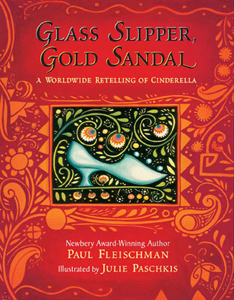
The Horn Book website has lots of material of interest to teachers. Here are some areas to explore. And follow us on Twitter: #lollysclass
|
Interviews with authors and illustrators Recommended books -- reviews and themed book lists |
School -- reading in school, author visits, and more Suggestion box: what else to you want to see in Lolly's Classroom? |
Glass Slipper, Gold Sandal
One of the fascinating and mysterious things about folklore is that the same story types appear all over the world.
 One of the fascinating and mysterious things about folklore is that the same story types appear all over the world. Here's a single picture book that tells a Cinderella-type story as found in several different cultures.
One of the fascinating and mysterious things about folklore is that the same story types appear all over the world. Here's a single picture book that tells a Cinderella-type story as found in several different cultures.I think children would need to first be familiar with a single, cohesive version of this story in order to appreciate this book, but that is easily done. There are plenty of terrific stand-alone picture books of Cinderella, Cendrillon, etc., including our old friend John Steptoe's Mufaro's Beautiful Daughters.
What do you make of this one? Notice how the story is made cohesive, yet also kept separate, thanks mostly to Paschkis's illustrations and the book's design. Does this work for you? For children?

RELATED
RECOMMENDED
ALREADY A SUBSCRIBER? LOG IN
We are currently offering this content for free. Sign up now to activate your personal profile, where you can save articles for future viewing.







Add Comment :-
Comment Policy:
Comment should not be empty !!!
Lynn Van Auken
I begin my 2nd grade Cinderella study with Glass Slipper, Gold Sandal for two reasons: 1 - most students are already familiar with the French version, and 2 - I don't want to imply that the French - or any other version - is the "standard" against which all other Cinderella stories should be compared. I find children are able to follow Fleischman's story whether or not they are familiar with other Cinderella stories, as long as we discuss the format and basis of this retelling before we read it. Then, we read complete versions of a bunch of the variations touched upon in this book, and do compare/contrast work as we go. The largest minority population in our school is Brazilian, and I've yet to find a Cinderella story set in Brazil, or any South American country, for that matter. These students always ask, I tell them I don't know of any, and in turn ask them to ask their parents, but one has yet to turn up. Does anyone know of a South American Cinderella? I'd love to add it to our study.Posted : Apr 10, 2014 01:07
Nell O'Donnell
I loved this book. It reminded me of a project I worked on a few years ago where I collected different versions of the "stone soup" folktale. I wonder, though, how aware a young child would be of how interesting this book is, or whether the child might be confused that the shoe changes styles (etc.) over the course of the story. The illustrations were amazing, though, and I think would capture any child's imagination.Posted : Apr 03, 2014 08:17
Robin TF
This was a beautiful retelling, and the multicultural detail made it an engaging read, even after having read Cinderella as many times as I have. One of the things I love about fairy tales is the 'time travel' element - the ancient oral tradition cadence combined with the little details take the reader to another time or place. Details in the language as simple as a stewpot on an open fire, or a cottage, or sandals and figs... This version of the story offers a satisfying level of this type of detail. If anyone is interested, I recently read a version of Cinderella ("Cinder Maid") that I hadn't heard in a long time. (See link below.) My classmates in my discussion group always laugh when I reveal my childhood proclivity for the gorier tales, so anyone reading this will not be surprised that it was the version in which the step-sisters cut off their toes to fit into the glass slipper. I wouldn't expect this to be added to this beautiful children's story, but I am curious if the author encountered any more of this type of detail in the story, or if that's just limited to early editions of Grimm's. But in addition to the gruesome, there were other exciting details reminiscent of the story "Donkeyskin" in that Cinderella retrieves ethereally beautiful dresses from nutshells. This reminded me that one of the most enthralling pieces of Cinderella to children and adults alike is the great transformation: wearing rags and suddenly wearing the most beautiful dress you've ever seen; having nothing and suddenly having everything. Apparently makeovers are a trope that long predates Shaw's Pygmalion or ABC's Extreme Makeover. Because the "makeover" is such a powerful part of the story, I would have loved to hear (and see) more detail about the transformation of the maiden and her various accoutrements. http://www.gutenberg.org/files/26019/26019-h/26019-h.htm#THE_CINDER-MAIDPosted : Apr 02, 2014 07:57
Long Phan
I agree with much of what's already been said. I do believe that children will need a basic familiarity with the Cinderella story in order to fully appreciate this multicultural retelling. I'm extremely familiar with the Cinderella story but found myself asking "what is going on" after the first page. From a design standpoint, I enjoyed the endpapers which featured a map of the countries represented. I adored the art on every page, and loved that it reflected the style, people, and animals of each country. Also, the country names and color themes were helpful in transitioning from page to page, and country to country. My favorite country was Indonesia which reminded me of my grandpa who used to have some of the same Indonesian shadow puppets in his house.Posted : Apr 02, 2014 07:25
Marina Chan
This is a beautiful book and the first I have come across that weaves different cultures into the same story. Without repeating my colleagues' comments, I appreciate the constance of portraying Cinderella with long straight black hair. I would imagine this would help the child reader focus on this character in the myriad of cultural shifts. I also appreciate on some pages in the book the background illustrations which add elaboration to the main illustration and text. I do echo some of the earlier comments that adding artistic elements unique to the culture would have brought more authenticity.Posted : Apr 02, 2014 06:09